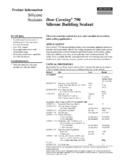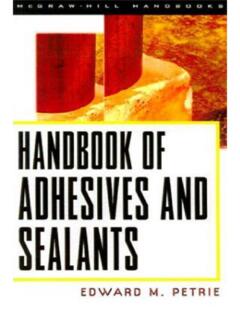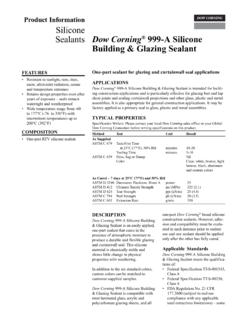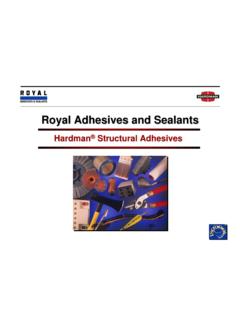Transcription of Recommendations for Selecting and Using Caulks and ...
1 Recommendations for Selecting and Using Caulks and Sealants in Pest management operations Bobby Corrigan, RMC Pest management Consulting Richmond, IN. The terms caulk and sealant are sometimes used interchangeably, but they are actually two different things. Caulks or caulking compounds are non-elastomeric. This means they do not return to their original size and shape after being stretched or compressed. Caulk materials are used for filling small joints [1/4 (6mm or less)] where little or no movement is expected. Sealants are elastomeric materials used to seal joints where movement is ex- pected (typically 25 to 50%). A third type of material that is used in pest exclusion is a sealer. A sealer is a liquid coating applied to surfaces for filling pores and hairline cracks. All of these materials provide a weather-tight (and pest proof) means of closing openings in structures.
2 Choosing Caulks and sealants Those involved in attempting to seal pests out of buildings need to know how to choose the right caulk or sealant for each situation. The choice of material might not seem too important because any of the materials will fill a crack or a gap. The question is how long the crack or gap will need to remain filled. Choosing the material best suited to each situation will help ensure a long-lasting repair. The following factors should be considered when choosing a caulk or sealant . Amount of movement expected at the joint. Generally, less movement is expected at a joint between the same materials ( , wood-to-wood) than between different materials ( , wood-to-glass). One obvious exception is concrete-to-concrete expansion joints, especially on surfaces that have vehicular traffic ( , warehouse floor). Compatibility between the surface and the caulk/ sealant materials.
3 Some surfaces are inherently difficult to get materials to adhere to ( , wet, frozen, deteriorated, oil contaminated). Life expectancy of the caulk/ sealant ( , resistance to moisture, wear, oxidation, high temperatures and UV light). Service and application temperature ranges. Appearance (especially paintability). Ease of handling and application. These characteristics for the common Caulks and sealants are summarized in Table 1, page 2. Table 1. Characteristics of Caulks and sealants used in pest exclusion. Material* Max. Joint Surface Life Expectancy Service Application Paintable Movment Compatibility** (Years)** Temp. Temp. Caulks . 1-2 ext -20 to 180F >40 F. Oil Based 2% non-porous yes 10 int. (-30 to 82C) (4 C). most, -20 to 200F >40 F yes, Butyl esp. masonry 7-10. concrete (-30 to 93C) (4 C) slow cure -20 to 150F >40 F yes, Latex 2% most 3-5 int (-30 to 65C) (4 C) fast cure 1-2 ext -20 to 180F >40 F.
4 Acrylic Latex 2% most yes 3-10 int (-30 to 82C) (4 C). Urethane 10-20, -20 to 250F >70 F. 0% most (21 C) yes Foam if protected (-30 to 120C). SEALANTS. Siliconized most, -20 to 180F >32 F. 25% except plastics 20-30 (-30 to 82C) yes Acrylic Latex (0 C). Ethylene most, -20 to 200F. Copolymer >0 F. 25% except plastics 10-20 (-30 to 93C) yes (Geocel TM) (-18 C). Polysulfide -40 to 250F >60 F. 25% varies 10-20 unknown (-40 to 120C) (15 C). Urethane most, -40 to 250F >40 F. 25% 20-30 unknown except glass (-40 to 120C) (4 C). -65 to 350F >0 F. Silicone 12-50% varies 20-30 no (-54 to 175C) (-18 C). * Except ethylene copolymer, materials listed in this column are manufactured and sold by several companies. **How well the material adheres to different substrates. Varies indicates much variability in surface compatibilities among the products within a certain class of material.
5 Manufacturers should be consulted for specific information on the suitability of their products for different uses. ** ext=exterior use, int=interior use --- materials with shorter exterior than interior life are subject to accelerated breakdown by UV light, oxidation and weathering









